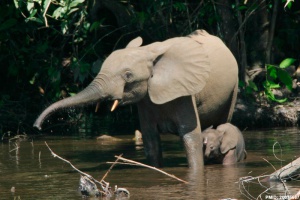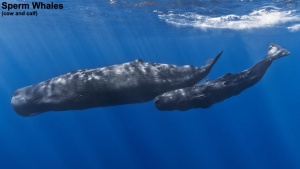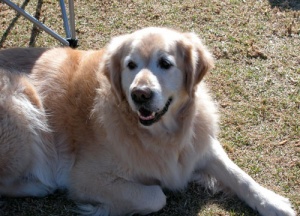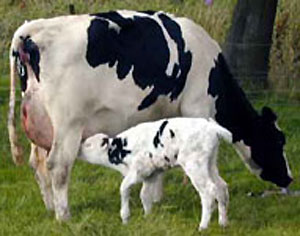About Development Times

African elephant cow and calf
The number of days development before birth or hatching in the table below are the typical days value, some individual animals may be shorter or longer by different number of days. Note also that reptile and bird incubation times are affected by the environmental temperature, colder is generally longer.
| For the Teacher
|

- I have only asked questions that answers can be found on this page or easily researched.
- This table can be sorted by either the animal name or by the days development (by clicking the triangles in the column headings).
- This content is only designed for K12 students to make them think about comparative development and does not cover other developmental topics.
- More detailed animal information can be found by clicking on the animal pictures on this page.
- Detailed information, not designed for K12, can be found on the lefthand menu Animals pages.
Additional Research Questions (not answered on this page)
- How many young each animal species can give birth to at once?
- Which newborn animals are fed milk (mammals) by their mothers?
|
Questions
- Which animals have the shortest and longest development times?
- Which is the biggest animal?
- Which is the smallest animal?
- Which animals live in our homes or on a farm (domestic)?
- Which animals live in the wild or seen in zoos?
Animal Development Time
| Animal
|
Average Days
|
| Bear (Black)
|
210
|
| Bison
|
270
|
| Budgerigar
|
18
|
| Camel
|
410
|
| Cat
|
65
|
| Cattle
|
281
|
| Chicken
|
21
|
| Chimpanzee
|
236
|
| Chinchilla
|
111
|
| Coyote
|
63
|
| Deer (Mule)
|
200
|
| Dog
|
63
|
| Donkey
|
365
|
| Duck
|
28
|
| Duck (Muscovy)
|
35
|
| Elephant
|
660
|
| Elk, Wapiti
|
255
|
| Ferret
|
42
|
| Finch
|
14
|
| Fox
|
52
|
| Giraffe
|
425
|
| Goat
|
150
|
| Goose
|
28
|
| Gorilla
|
270
|
| Guinea fowl
|
28
|
| Guinea pig
|
68
|
| Hare
|
36
|
| Hippopotamus
|
240
|
| Horse
|
338
|
| Human
|
274
|
| Leopard
|
95
|
| Lion
|
108
|
| Llama
|
350
|
| Marmoset
|
150
|
| Mink (European)
|
41
|
| Monkey (Macaque)
|
180
|
| Moose
|
240
|
| Mouse
|
20
|
| Muskox
|
255
|
| Muskrat
|
29
|
| Nutria, Coypu
|
130
|
| Opossum
|
12
|
| Otter
|
285
|
| Panther
|
90
|
| Parrot
|
26
|
| Pheasant
|
24
|
| Pig
|
114
|
| Pigeon
|
18
|
| Porcupine
|
210
|
| Pronghorn
|
230
|
| Quail
|
16
|
| Rabbit
|
31
|
| Raccoon
|
63
|
| Rat
|
21
|
| Reindeer
|
225
|
| Rhinoceros (African)
|
480
|
| Seal
|
330
|
| Sheep
|
150
|
| Shrew
|
20
|
| Skunk
|
63
|
| Squirrel (Gray)
|
40
|
| Swan
|
35
|
| Tapir
|
390
|
| Tarsier
|
182
|
| Tiger
|
103
|
| Turkey
|
28
|
| Walrus
|
450
|
| Whale (Sperm)
|
450
|
| Wolf
|
63
|
| Woodchuck
|
31
|
| Animal Notes and Table Data Sources
|
|
Notes
- Each animal species has different variations +/- the average values shown in the table.
- Gestation is the carrying of an animal embryo or fetus inside a female animal.
- Incubation is the laying of an egg (birds, reptiles, monotremes) with development occurring outside the female animal.
Data Sources
- The House Mouse: Atlas of Mouse Development by Theiler Springer-Verlag, NY (1972, 1989).
- The Genetics of the Dog. E Ostrander, E. and Ruvinsky, A. ISBN: 9781845939403 (2012)
- Merck Veterinary Manual. Aiello, S.E. and Moses, M.A. (ed) ISBN: 0911910506 (2013) Online
- Witschi, E. (1962) Development: Rat. In: Growth Including Reproduction and Morphological Development. Altman, P. L. , and D. S. Dittmer, ed. Fed. Am. Soc. Exp. Biol., Washington DC, pp. 304-314.
|
| Animal Development Time
|
| Animal
|
Average Days
|
| Bear (Black)
|
210
|
| Bison
|
270
|
| Budgerigar
|
18
|
| Camel
|
410
|
| cat
|
65
|
| cow
|
281
|
| chicken
|
21
|
| Chimpanzee
|
236
|
| Chinchilla
|
111
|
| Coyote
|
63
|
| deer (Mule)
|
200
|
| dog
|
63
|
| Donkey
|
365
|
| Duck
|
28
|
| Duck (Muscovy)
|
35
|
| elephant
|
660
|
| Elk, Wapiti
|
255
|
| Ferret
|
42
|
| Finch
|
14
|
| Fox
|
52
|
| Giraffe
|
425
|
| goat
|
150
|
| Goose
|
28
|
| Gorilla
|
270
|
| Guinea fowl
|
28
|
| guinea pig
|
68
|
| Hare
|
36
|
| Hippopotamus
|
240
|
| horse
|
338
|
| Human
|
274
|
| Leopard
|
95
|
| Lion
|
108
|
| Llama
|
350
|
| Marmoset
|
150
|
| Mink (European)
|
41
|
| monkey (Macaque)
|
180
|
| Moose
|
240
|
| mouse
|
20
|
| Muskox
|
255
|
| Muskrat
|
29
|
| Nutria, Coypu
|
130
|
| opossum
|
12
|
| Otter
|
285
|
| Panther
|
90
|
| Parrot
|
26
|
| Pheasant
|
24
|
| Pig
|
114
|
| Pigeon
|
18
|
| Porcupine
|
210
|
| Pronghorn
|
230
|
| Quail
|
16
|
| rabbit
|
31
|
| Raccoon
|
63
|
| rat
|
21
|
| Reindeer
|
225
|
| Rhinoceros (African)
|
480
|
| Seal
|
330
|
| sheep
|
150
|
| Shrew
|
20
|
| Skunk
|
63
|
| Squirrel (Gray)
|
40
|
| Swan
|
35
|
| Tapir
|
390
|
| Tarsier
|
182
|
| Tiger
|
103
|
| Turkey
|
28
|
| Walrus
|
450
|
| whale (Sperm)
|
450
|
| Wolf
|
63
|
| Woodchuck
|
31
|
|
Animal Notes and Table Data Sources
- Each animal species has different variations +/- the average values shown in the table.
- Gestation is the carrying of an animal embryo or fetus inside a female viviparous animal. Except in the case of human gestational age GA.
- Incubation is the laying of an egg (birds, reptiles, monotremes) with development occurring outside the female animal.
See also - Timeline Comparisons
Additional Data Sources
- Theiler K. The House Mouse: Atlas of Mouse Development (1972, 1989) Springer-Verlag, NY. Online
- Witschi E. Rat Development. In: Growth Including Reproduction and Morphological Development. (1962) Altman PL. and Dittmer DS. ed. Fed. Am. Soc. Exp. Biol., Washington DC, pp. 304-314.
- The Genetics of the Dog. E Ostrander, E. and Ruvinsky, A. ISBN: 9781845939403 (2012)
- Merck Veterinary Manual. Aiello, S.E. and Moses, M.A. (ed) ISBN: 0911910506 (2013) Online
- Witschi, E. (1962) Development: Rat. In: Growth Including Reproduction and Morphological Development. Altman, P. L. , and D. S. Dittmer, ed. Fed. Am. Soc. Exp. Biol., Washington DC, pp. 304-314.
|
Animal Notes
- Each animal species has different variations +/- the average values shown in the table.
- Gestation is the carrying of an animal embryo or fetus inside a female animal giving live birth.
- Incubation is the laying of an egg (birds, reptiles, platypus, echidna) with development occurring outside the female animal.
Cite this page: Hill, M.A. (2024, April 27) Embryology K12 Animal Development Times. Retrieved from https://embryology.med.unsw.edu.au/embryology/index.php/K12_Animal_Development_Times
- What Links Here?
- © Dr Mark Hill 2024, UNSW Embryology ISBN: 978 0 7334 2609 4 - UNSW CRICOS Provider Code No. 00098G





